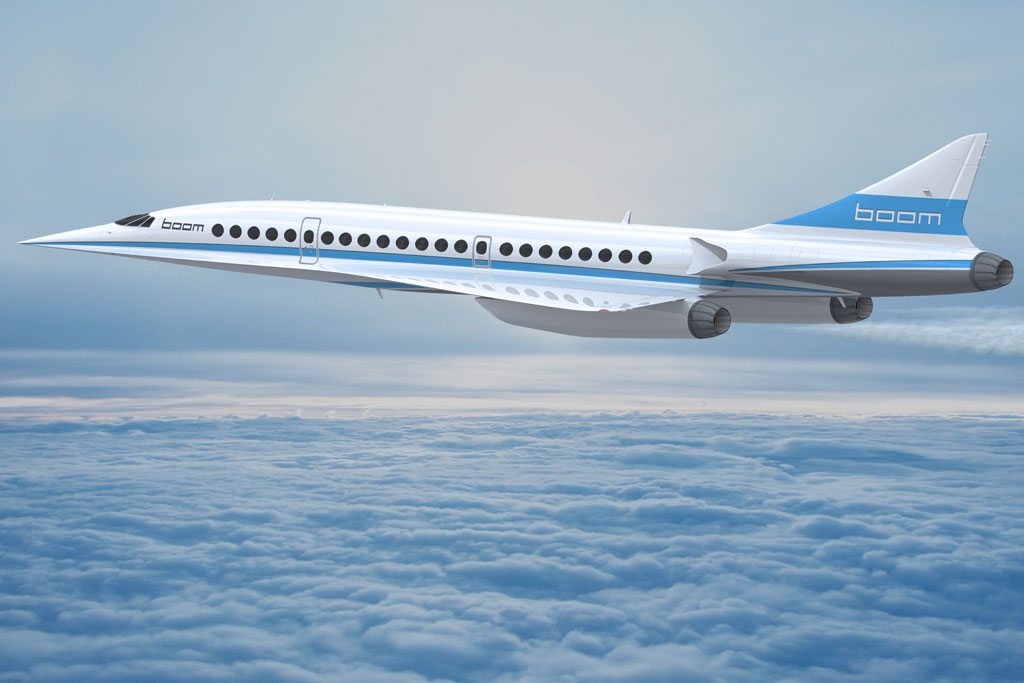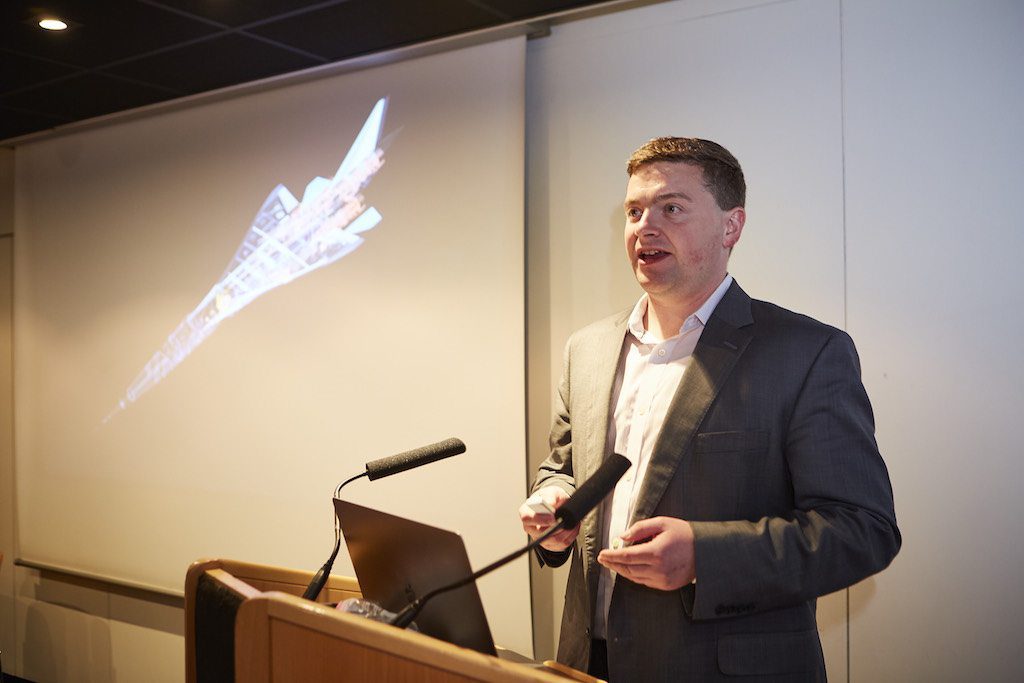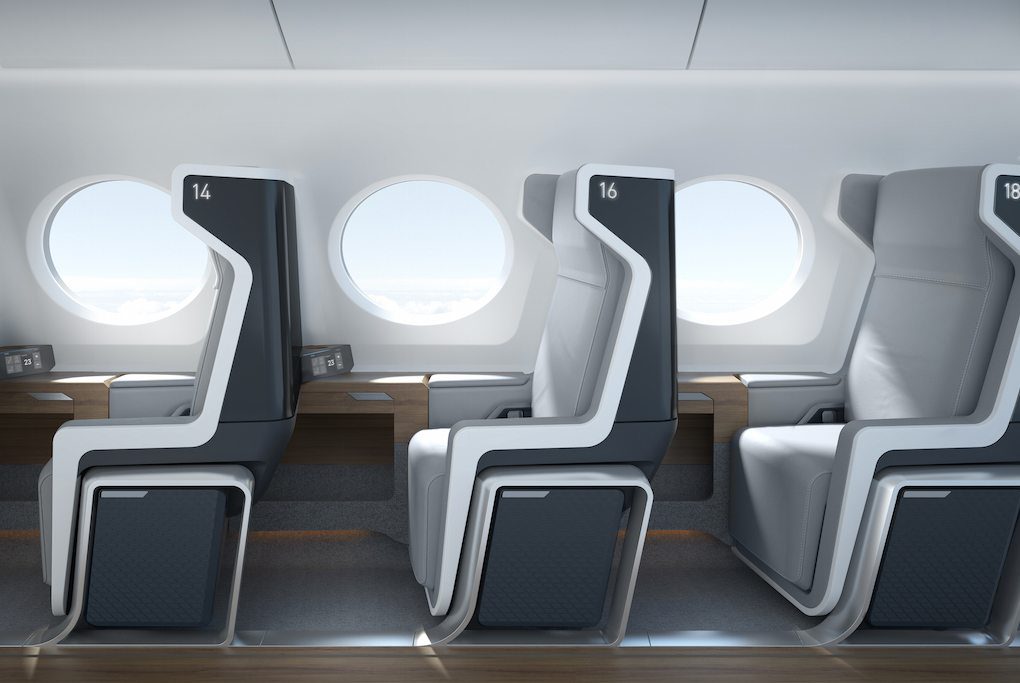Skift Take
We think there's probably demand for this airplane for transatlantic routes. Wouldn't it be great to fly between London and New York in fewer than three hours? But the airplane would have to make a fuel stop on longer routes, so it might be less useful from, say, Tokyo to Los Angeles or London.
It has been more than a decade since travelers regularly crossed the Atlantic at supersonic speeds on Concorde, a marvel of 1960s engineering. Now, one entrepreneur is hoping to build a new plane that again will fly between New York and London in fewer than three hours.
He’s Blake Scholl, a software engineer by training and an aviation geek at heart. In 2014, he co-founded a company called Boom, based in Denver. As soon as 2023, he promises it will deliver a cost-effective supersonic plane that’ll fly more than 4,000 nautical miles without stopping. The company’s demonstrator — a scaled-down version of the real thing, called Baby Boom — should fly at some point next year.
Over the past three years, Scholl has met plenty of doubters. The naysayers know supersonic for commercial jets is technically viable because Concorde proved it years ago. But some wonder if Boom’s leadership is underestimating how difficult it will be to build and market a supersonic jet within six years.
“I think all of us in the aerospace world really love the idea of supersonic,”said Richard Aboulafia, vice president for analysis at Teal Group Corp., an aerospace consultancy. “It’s just the practical realities are somewhere between painful and difficult.”
Two issues continue to come up. One is the size of the potential market: It’s not clear how many airlines would want supersonic planes, which go for $200 million each, considering their conventional jets perform just fine. Another concern could be the airplane’s engines.
“They do not have an engine, nor is there one available off the shelf,” Aboulafia said. “There might be people who have come to them with concept engines for the future, but in terms of of- the-shelf options, there’s nothing. Nada.”
But Scholl, a relentlessly positive leader who last worked at Groupon, said he’s not worried about the engine — or anything else. “We’re happy with the engine options in front of us,” he said. And he cites a report by the Boyd Group, a consulting firm, that suggests the company could sell 1,300 airplanes in 10 years.
We spoke to Scholl recently at the Boyd Group’s annual International Aviation Forecast Summit in Las Vegas to ask him why he’s so sure supersonic travel is both technically possible and will be embraced by airlines.
Note: This interview has been edited for length and clarity.
Skift: When will your first real airplane — not the demonstrator — fly?
Our goal is to have the first pre-production aircraft in air in 2020, entering into service in 2023. It’s not as close as we would love it to be, but it’s also not infinitely far in the future. The reason is that this is an engineering project, not a science project. All the key technology for the airplane already exists. It’s a matter of getting the development done, getting it through certification and into service.
Skift: Let’s be honest. Planes are often delayed. Will you make 2020 for the first flight?
Scholl: I think one thing that’s important to keep in mind here is Boeing and Airbus both have lots of things in the oven. Boom is only working on one thing — the supersonic renaissance. We are 100 percent focused on it. There is no new technology we have to develop to make this thing happen. That makes the schedule very viable. It’s certainly a challenging project but not an impossible one.
Skift: There’s nothing vexing you must solve?
Scholl: No. That’s the surprising thing about supersonic. Remember, Concorde was designed 50 years ago with slide rules. It has been half a century since we have had a speed-up in air transportation — since we went from props to jets. And while we have had no progress in speed, we have had tremendous progress in how you build airplanes. We have new materials, like carbon-fiber composites. We have turbofan engines that are more efficient, quieter, and more environmentally friendly. And we have new methods of doing aerodynamic development through simulation that make it possible for small teams to go accomplish what used to take tens of millions of dollars and huge teams.
If you take all those bits and pieces together — things that have been flying on other aircraft, that are already certified — you can build a second-generation supersonic transport that is enough more efficient compared to Concorde that the economics work. You don’t need any science projects for that. You don’t need some new kind of engine or some crazy kind of wing. This is all stuff that has been done before.
Skift: When will the demonstrator fly?
Scholl: End of next year. We are making great progress on it. We just completed our second round of wind tunnel testing. It came out with a clean bill of health. We are getting the thing built and putting it together.
Skift: What about funding? Do you have enough to see you through?
Scholl: Funding I am very happy to say is not the problem. We have publicly raised $41 million for the company. That’s not enough to go build a production-certified airliner, of course, but it is enough to get the demonstrator flying. The way you go finance a startup venture is you go raise money, you accomplish milestones, and you go raise money and you accomplish more milestones. Ultimately, this is going to be a capital-intensive project but if you look at the capital requirements, it’s all obtainable amounts of money.
Skift: Is there a launch customer?
Scholl: The global launch customer is Virgin Atlantic.
Skift: Richard Branson is a major backer of yours. But in July, he said he was selling a major part of his stake in Virgin Atlantic to Air France-KLM, though he’ll remain chairman. Does this affect your deal with the airline?
Scholl: No. We have a great relationship with Virgin at many levels. Richard has been instrumental in making that happen, but the teams at the various Virgin airlines are very excited about supersonic. Richard’s role is evolving but it’s not going to zero, and the interest is still there at every level of the organization.
Skift: You’re very well educated, but you’re not an aerospace engineer. How’d this become your business?
Scholl: I’m a software engineer by training, and an airplane guy by passion. Something I believe very deeply is if you have a good sense of what clarity feels like, and you’ve got a lot of drive, you can go off and learn things pretty quickly. I have been fortunate at Boom to surround myself with some incredible people who live and breathe airplanes. The roster of folks we have been able to assemble to tackle a challenging but possible mission is really quite exciting. It makes this thing that may sound intractable actually possible.
Skift: Is there a list price for this airplane?
Scholl: There’s a list price and an actual price and they’re the same number. This is unorthodox. But when you go build a differentiated product, you get to rewrite some of the rules. And the silliness, where it’s like ‘guess the price,’ doesn’t need to exist. The airplane costs $200 million. Full stop.
[Editor’s note: Big manufacturers like Boeing and Airbus post “list prices” for airplanes, but just about every carrier gets major discounts, often at least 50 percent or more.]
Skift: What about operating costs?
Scholl: It’s about 75 percent less expensive to operate than Concorde. Part of that is improved fuel efficiency. Part of that is getting a form factor that will work at much higher rates of utilization and therefore reduce the capital costs per flight. That’s actually really huge. That facilitates ticket prices that are profitable at just a quarter of the cost of flying Concorde.
A roundtrip ticket on a Boom flight to London will be profitable for the airline at $5,000. That’s about what you pay in business class subsonic today. That’s what makes this such a compelling proposition. From a passenger perspective, you can pay what you’re paying today and get there in half the time. Who would not want to do that?
Airlines make the lion’s share of their revenue and margin in premium class and the cost structure of this supports maintaining those margins or possibly even extending them.
Skift: At the Paris Air Show in June, you said five customers have ordered 76 airplanes. You only named Virgin Atlantic. The other airlines were top secret. Can you tell us more?
Scholl: We are going to hold some separate events in the coming months to speak very specifically about who those customers are and how they see supersonic fitting into their fleets. So I can’t name them aside from Virgin.
But this is a global product. When we talk about who these customers are, you’re going to see great diversity in geography.
Skift: How far can your airplane fly?
Scholl: The maximum range of the aircraft is 4,500 nautical miles, or just over 5,000 statute. Transatlantic routes are absolutely no problem. It’s got longer legs than Concorde.
Transpacific is interesting because basically the rebirth of supersonic is going to look a lot like the birth of the jet back in the late 1950s and early 1960s. Across the Pacific, you’ll fly with a tech [or fuel] stop, and you still save half the time. The same thing happened with props to jets. In the first generation, you lost a little bit of legs but you gained so much speed that no one cared.
Skift: How long will New York to London take?
Scholl: Three hours and 15 minutes, gate-to-gate.
Skift: And in the air?
Scholl: A little bit less than three. It’s a bit faster than Concorde. We’re cruising 10 percent faster than Concorde. It’s Mach 2.2 or 1451 mph.
Skift: For Asia to North America, are you sure everything will require a tech stop, including shorter routes like Seattle-Tokyo?
Scholl: That’s right at the limit of what you can do nonstop. Most of the routes — for example L.A. to Sydney — you actually do a tech stop. That one, for example, is 6 hours, 45 minutes, including the tech stop. If you’re doing San Francisco to Shanghai, you stop in Anchorage.
People think of stops as this miserable thing. You go to the gate. You get off the airplane. You have to change planes. You might miss your connection. That’s awful. Nobody wants that. A supersonic fuel stop is much different. You land. The fuel truck comes over. You don’t get out of your seat. You gas up the tanks, you taxi to the other end of the runway, and you’re back up in the air. It’s a very streamlined experience.
Skift: Could you do New York-L.A?
Scholl: It all comes down to the politics of it. In the early 1970s, the FAA imposed this speed limit over land in the U.S. This is the No. 1 reason why this hasn’t happened already. We took high-speed travel over the Continental U.S. off the table, basically to block Concorde. Concorde was that evil European thing and we didn’t have anything American to compete with it.
The Boom aircraft flies Mach 2.2 over water. And over land, we’ll fly high subsonic. We’ll be about 15 percent faster at Mach .95 over land than traditional jets, with that speed limit in place. And so is that useful transcon? Is 15 percent enough to generate a big market? I wouldn’t be surprised if we found a couple flights there. But it’s not going to be transformative until you can do high speed over land.
We’re working to make that happen. It’s much more about the politics than the technology or the noise. People talk about sonic booms like they are these things that kill babies. The reality is there are a whole lot of other background noises you put up with that are far louder than a sonic boom. We’re working on getting those rules changed. We are not counting on it, but it would be great.
Skift: Is there demand for speed anywhere but the world’s most dense and wealthiest cities, such as New York, London, and Tokyo?
Scholl: There’s about 500 routes on the planet that have enough traffic today to support regular supersonic service. That’s about the form factor of the aircraft and that’s about the economics. Concorde with 100 seats and ticket prices that were four times subsonic worked on one route. It could not make money anywhere but New York to London. But if you get the operating costs down by 75 percent on a per seat basis, and then even more on a per trip basis, because the vehicle is smaller, it can work on a whole bunch of routes.
It’s not just New York to London. It’s Seattle to Shanghai, and L.A. to Sydney. Tokyo to Perth. There are plenty of routes where you have enough overwater time that you get a big speed up for passengers and enough travel volume that you can get a great load factor.
Skift: For the business class passengers Boom wants to attract, even a 15-hour long-haul flight like Los Angles-Sydney isn’t so bad. You have drinks, and dinner, then watch a couple of movies and then sleep for nine hours. You arrive in the morning. Is it so much better to fly seven hours but stop in Tahiti?
Scholl: History says when the faster flights come online, nobody flies the slower ones. The faster flight is just better.
Skift: Will airlines have to charge more for flights operated by your planes?
Scholl: They’ll be at parity with business class. Your choice will be: Do you want to spend 16 hours in a flatbed seat or do you want to speed six or seven hours and truly go to sleep and wake up in the other city?
We’re not talking Concorde. The premium for flying Concorde was 4x. We’re talking no premium for speed.
Skift: How do you expect airlines will configure your airplanes?
Scholl: There are two cabin options. There is business class and first class.
Business class supersonic is a nice wide seat, with a big 24-inch screen in front of you, plenty of space, and it reclines but not fully lay-flat. That’s perfect for the transatlantic flights. Think New York to London — 3 hours and 15 minutes. You don’t need the flatbed seat. By the time you put it down, it’s time to put it back up. You are able to get better operating economics with the increased density.
Across the Pacific, we see a lot of interest in a two-class cabin, or on some of the longest segments, there is interest in just doing a full first class cabin.
If you do full first class, it’s about 32 seats, and those are all lay-flat. You can do mix [of business and first] that’s in the 40s, or you do an all-business at 55.
Skift: How firm are your orders?
Scholl: The way this works is airlines place pre-orders now. There’s real cash money against that. It’s not just a [letter of intent]. After we fly the demonstrator, we are going to firm up things like performance guarantees on the aircraft. At that point, all the orders become firm.
Skift: Airline people tend to be risk averse. Is it hard to sell to them?
Scholl: The first one was a challenge, but you get momentum. The reason people get excited is just basic fundamentals. If you’re an airline person today, your life is hard. It’s a tough business because you’re flying basically the same airplanes from the same airports with basically the same cabin [as your competitors]. That’s why in economy there’s all this brutal cost competition — how low can you get the price? And in premium class, it’s like, ‘Fly my airline. I’ve got the best wine.’ It’s weak differentiation. That’s why we have all these loyalty programs.
The basic value we offer to airlines is, ‘Hey, do you want to offer something that’s really different?’ Would passengers switch airlines to get there in half the time? Would they walk away from their frequent flyer miles for that? The answer is in many cases yes. And that gives an airline a really interesting competitive weapon.
The Daily Newsletter
Our daily coverage of the global travel industry. Written by editors and analysts from across Skift’s brands.
Have a confidential tip for Skift? Get in touch
Tags: airline passenger experience, supersonic
Photo credit: Denver-based startup Boom is hoping airlines can fly its supersonic jets by 2023. A rendering of the aircraft is pictured here. Boom Technologies


